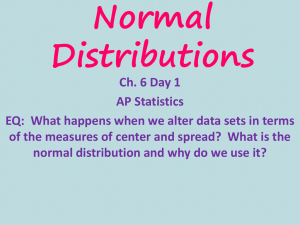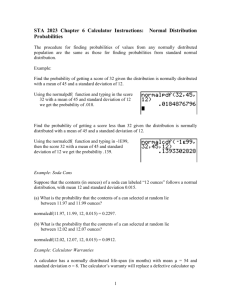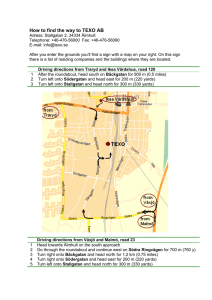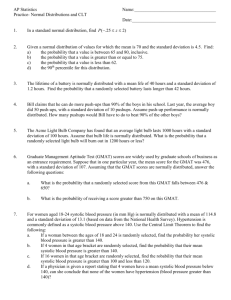File
advertisement
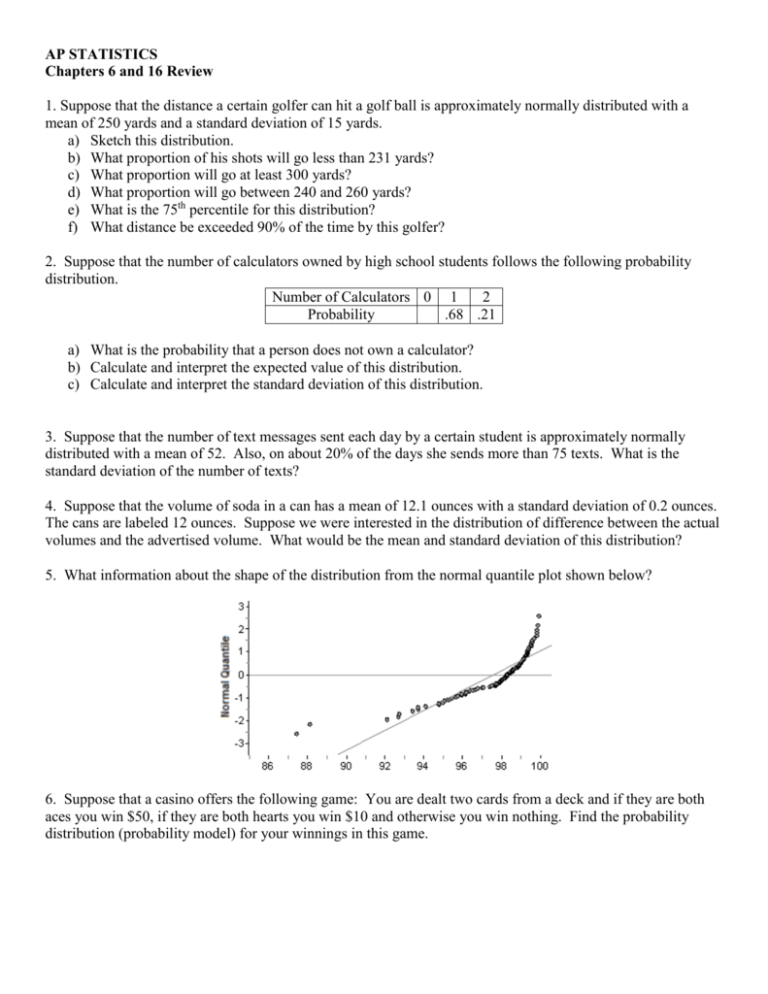
AP STATISTICS Chapters 6 and 16 Review 1. Suppose that the distance a certain golfer can hit a golf ball is approximately normally distributed with a mean of 250 yards and a standard deviation of 15 yards. a) Sketch this distribution. b) What proportion of his shots will go less than 231 yards? c) What proportion will go at least 300 yards? d) What proportion will go between 240 and 260 yards? e) What is the 75th percentile for this distribution? f) What distance be exceeded 90% of the time by this golfer? 2. Suppose that the number of calculators owned by high school students follows the following probability distribution. Number of Calculators 0 1 2 Probability .68 .21 a) What is the probability that a person does not own a calculator? b) Calculate and interpret the expected value of this distribution. c) Calculate and interpret the standard deviation of this distribution. 3. Suppose that the number of text messages sent each day by a certain student is approximately normally distributed with a mean of 52. Also, on about 20% of the days she sends more than 75 texts. What is the standard deviation of the number of texts? 4. Suppose that the volume of soda in a can has a mean of 12.1 ounces with a standard deviation of 0.2 ounces. The cans are labeled 12 ounces. Suppose we were interested in the distribution of difference between the actual volumes and the advertised volume. What would be the mean and standard deviation of this distribution? 5. What information about the shape of the distribution from the normal quantile plot shown below? 6. Suppose that a casino offers the following game: You are dealt two cards from a deck and if they are both aces you win $50, if they are both hearts you win $10 and otherwise you win nothing. Find the probability distribution (probability model) for your winnings in this game. 7. A certain potato chip company produces two different kinds of potato chips: “Smooth” and “Ridges”. Bags of “Smooth” potato chips have weights that are approximately normally distributed with a mean of 230 grams and a standard deviation of 10 grams. a) If you were to randomly select 2 bags of “Smooth,” what is the probability that the total weight is over 450 grams? b) If you were to select 100 bags of “Smooth”, what is the probability that the total weight will be more than 23,100 grams? c) Bags of “Ridges” have weights that are approximately normally distributed with a mean of 240 grams and a standard deviation of 15 grams (the ridges make them more variable). If you randomly selected a bag of each type, what is the probability that the bag of “Ridges” is heavier than the bag of “Smooth”? 8. A random sample of 90 portable music players was selected and each was charged and then played until it ran out of power. The time each device lasted was recorded and plotted on the dotplot below. The mean of the Dot Plot Collection distribution is 1299.8 minutes with a standard deviation of 9.1 minutes. 280 290 300 310 320 Time (minutes) tim e a) If the distribution was normal, what percentage of times should be within 1 SD of the mean? b) What percentage of times were actually within 1 standard deviation of the mean? c) Even though the answers to parts (a) and (b) were not the same, it is possible that the population of times from music players is approximately normally distributed and that the difference between (a) and (b) was just due to sampling variability. To investigate, 100 samples of size 90 were selected from a normal Dot Plot Collection 2 population with a mean of 299.8 and a standard deviation of 9.1 and the percentage that were within 1 SD of the mean was recorded. Use the results from the simulation below to discuss if it is possible that the population is approximately normally distributed. 55 60 65 70 75 80 85 Simulated Percentage one within 1 SD of the Mean Chapters 6 and 16 Review Answers: 1. Let x = distance the golf ball travels ~ N(250,15) a) b) c) d) e) f) 220 235 250 265 280 231 250 P(x < 231) = P(z < ) = P(z < -1.27) = .1020 15 OR P(x < 231) = normalcdf(-999,231,250,15) = .1026 P(x > 300) = normalcdf(300,999,250,15) = .0004 (can also do with z-scores) P(240 < x < 260) = normalcdf(240,260,250,15) = .4950 (can also do with z-scores) (draw picture with area of .75 to left of boundary) boundary = invnorm(.75,250,15) = 260.1 yards OR x 250 From table: z = .67 = . Solving for x = 260.05 yards 15 (draw picture with area of .10 to left of boundary so .90 is to the right of the boundary. Boundary = invnorm(.10, 250, 15) = 230.8 yards (also can do with z-scores) 2. x = number of calculators a) P(x = 0) = 1 - .68 - .21 = .11 b) E(x) = 0(.11) + 1(.68) + 2(.21) = 1.1. If we were to take a large sample of students, we would expect the mean number of calculators per person to be around 1.1. c) x 0 1.1 2 (.11) 1 1.1 (.68) 2 1.1 (.21) = .56. If we were to take a large sample of 2 2 students, we would expect the number of calculators to vary from the mean by about .56 on average. 3. x = number of texts ~ N(52, ) (draw a picture of a normal curve centered at 52 with a boundary line at 75 dividing the lower 80% from the upper 20%). The z-score for an area to the left of .8 is z = .84 (from table or invnorm(.8)). Solve the following 75 52 for : .84 and get = 27.4 texts. 4. v = volume of can, v = 12.1 and v = 0.2. d = difference in volume = v – 12 d = v - 12 = 12.1 – 12 = 0.1 d = v = 0.2 (subtracting 12 from each volume does not change the spread) 5. We know the original distribution is not normal, since the normal quantile plot is not linear. We also know that the values on the left side of the distribution are farther to the left than we would expect in a normal distribution and the values on the right are not as far out as we would expect in a normal distribution. This indicated that the distribution is clearly skewed to the left. 6. P(win 50) = P(2 aces) = 4 3 = .0045 52 51 13 12 = .0588 52 51 P(win 0) = 1 - .0045 - .0588 = .9367 P(win 10) = P(2 hearts) = Winnings 50 10 0 Probability .0045 .0588 .9367 7. s = weight of smooth ~ N(230,10) a) s1 + s2 ~ N(230+230, 102 102 ) = N(460, 14.1) P(s1 + s2 > 450) = normalcdf(450,9999,460,14.1) = .7609 b) s1 + s2 +…+ s100 ~ N(230+230+ …+ 230, 102 102 ... 102 ) = N( 100 230 , 100 102 ) = N(23000, 100) P(s1 + s2 +…+ s100 > 23100) = normalcdf(23100,9999999,23000,100) = .1587 c) r = weight of ridges ~ N(240,15), r – s ~ N(240 – 230, 152 102 ) = N(10, 18.03) P(r > s) = P( r – s > 0) = normalcdf(0,99999,10,18.03) = .7104. 8. a) 68% b) 299.8 – 9.1 = 290.7 and 299.8 + 9.1 = 308.9 so 64/90 = 71.1% are within 1 SD of the mean. c) When sampling from a normal population, it is not unusual at all to get 71.1% or more within 1 SD of the mean. This occurred in about 30/100 or 30% of the trials in the simulation. Thus, it is definitely possible that the population of times is approximately normally distributed even though we did not get exactly 68% within 1 SD of the mean in our sample.
